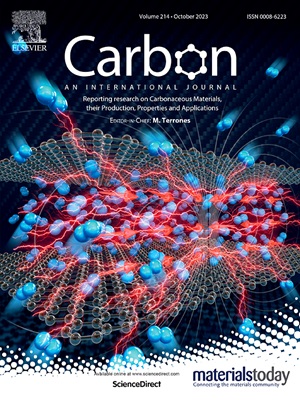Influence of acid-catalyzed dehydration and pressure on woody biomass carbonization: Exploring carbon yield, heteroatom functionalities, and biochar atomistic structure
IF 10.5
2区 材料科学
Q1 CHEMISTRY, PHYSICAL
引用次数: 0
Abstract
This study investigates optimal carbonization conditions for biochar production, focusing on pressure and acid pretreatments to maximize carbon yield and enhance biochar functionality. Over thirty combinations of pressure and acid type were tested, including organic acids (CH3COOH and HCOOH) and inorganic acids (H3PO4 and H2SO4), using hybrid poplar wood as feedstock. The results show that carbon conversion efficiencies up to 72 wt % were achieved with organic acids under pressures ≥ 20 bar. Inorganic acids produced biochar doped with phosphorus (P) and sulfur (S), demonstrating the potential for customizing biochar properties to specific applications. To understand biochar transformations at the molecular level, we employed a range of advanced characterization techniques, such as solid-state 13C NMR, ICP-OES, XPS, BPCA, LDI FT-ICRMS, and ESR, as well as 3D atomistic modeling of up to 13,000 atoms. These methods revealed how pressure and acid pretreatments influence the chemical composition, porosity, and atomistic structure of the resulting biochar. The study provides valuable insights into the relationship between processing conditions and biochar properties, demonstrating that optimized carbonization processes can improve production efficiency and reduce biomass requirements. This scalable approach offers significant potential for reducing carbon emissions and makes biochar a promising material for carbon storage, soil amendment, and other environmental applications.
酸催化脱水和压力对木质生物质碳化的影响:探讨碳产量、杂原子官能团和生物炭的原子结构
本研究探讨了生物炭生产的最佳碳化条件,重点是压力和酸预处理,以最大限度地提高碳产量和增强生物炭的功能。以杂交杨木为原料,对有机酸(CH3COOH和HCOOH)和无机酸(H3PO4和H2SO4)等30多种压力和酸型组合进行了试验。结果表明,在≥20 bar的压力下,有机酸的碳转化效率可达72 wt %。无机酸产生掺磷(P)和硫(S)的生物炭,展示了定制生物炭特性以适应特定应用的潜力。为了在分子水平上理解生物炭的转化,我们采用了一系列先进的表征技术,如固态13C NMR、ICP-OES、XPS、BPCA、LDI FT-ICRMS和ESR,以及多达13,000个原子的3D原子建模。这些方法揭示了压力和酸预处理如何影响所得生物炭的化学成分、孔隙度和原子结构。该研究对加工条件与生物炭特性之间的关系提供了有价值的见解,表明优化的碳化工艺可以提高生产效率并降低生物质需求。这种可扩展的方法为减少碳排放提供了巨大的潜力,并使生物炭成为碳储存、土壤修复和其他环境应用的有前途的材料。
本文章由计算机程序翻译,如有差异,请以英文原文为准。
求助全文
约1分钟内获得全文
求助全文
来源期刊

Carbon
工程技术-材料科学:综合
CiteScore
20.80
自引率
7.30%
发文量
0
审稿时长
23 days
期刊介绍:
The journal Carbon is an international multidisciplinary forum for communicating scientific advances in the field of carbon materials. It reports new findings related to the formation, structure, properties, behaviors, and technological applications of carbons. Carbons are a broad class of ordered or disordered solid phases composed primarily of elemental carbon, including but not limited to carbon black, carbon fibers and filaments, carbon nanotubes, diamond and diamond-like carbon, fullerenes, glassy carbon, graphite, graphene, graphene-oxide, porous carbons, pyrolytic carbon, and other sp2 and non-sp2 hybridized carbon systems. Carbon is the companion title to the open access journal Carbon Trends. Relevant application areas for carbon materials include biology and medicine, catalysis, electronic, optoelectronic, spintronic, high-frequency, and photonic devices, energy storage and conversion systems, environmental applications and water treatment, smart materials and systems, and structural and thermal applications.
 求助内容:
求助内容: 应助结果提醒方式:
应助结果提醒方式:


